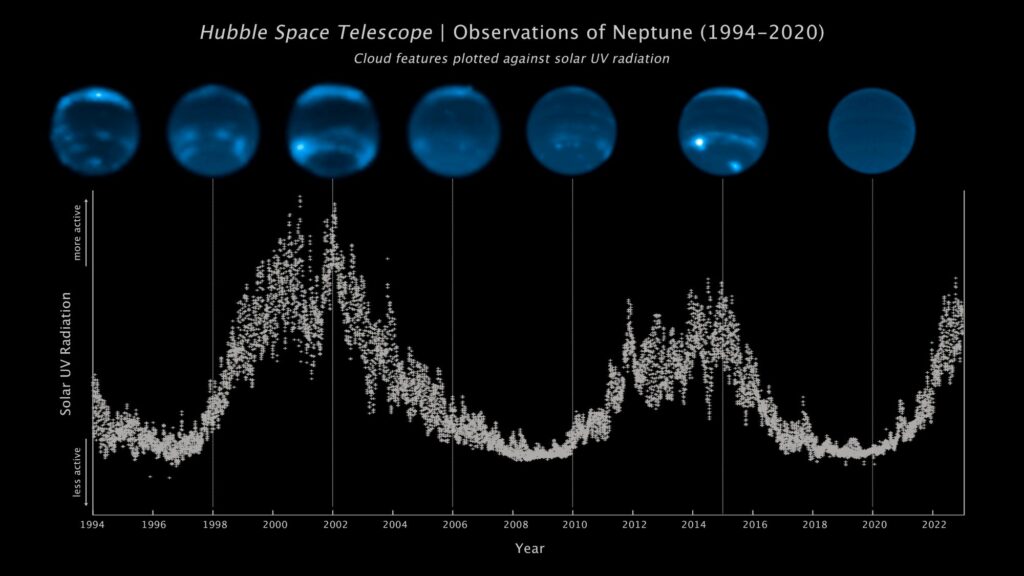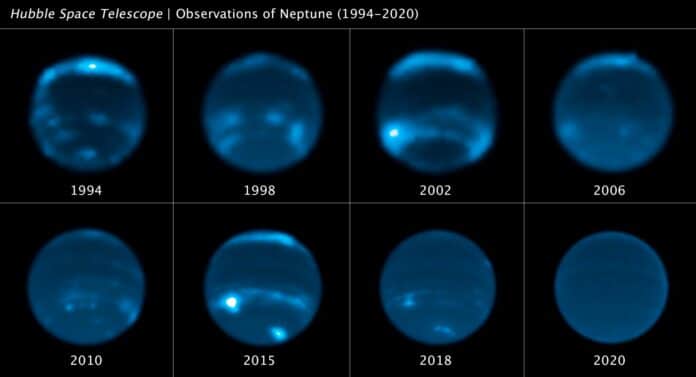The solar system’s most distant planet, Neptune, is an ice giant with a dynamic and disorderly atmosphere. Using ground-based measurements, the atmosphere’s long-term evolution was first investigated.
Astronomers tracked the evolution of Neptune’s cloud activity from 1994 to 2022 using archival near-infrared images from the Hubble Space Telescope, the Keck and Lick Observatories, and other observatories.
They determined the percentage of Neptune’s disk made up of clouds, the average brightness of cloud features, and the background without clouds. They came across something unexpected.

They were surprised by how quickly the clouds on Neptune disappeared. The drop mostly took place in a short period.
Astronomers believe there is a connection between Neptune’s changing cloud abundance and the 11-year solar cycle, driven by the waxing and waning of the Sun’s entangled magnetic fields.
Neptune has very little cloud coverage except for a few clouds floating over the giant planet’s south pole. A team of astronomers from the University of California (UC) Berkeley found that the number of clouds typically present in the icy giant’s mid-latitudes began to diminish in 2019.
In recent years, images from the Twilight Zone program and the Hubble’s Outer Planet Atmospheres Legacy (OPAL) program have been used to supplement the Keck observations.
The images show an intriguing correlation between the solar cycle, which occurs every 11 years when the Sun‘s magnetic field grows increasingly tangled like a ball of yarn, and seasonal variations in Neptune’s cloud cover. The rising sunspot count and rising solar flare activity indicate this. The Sun’s turbulent behavior increases as the cycle goes on and reaches its peak just before the magnetic field dips and flips polarity. The Sun then returns to its minimum level before beginning a new cycle.
Stronger ultraviolet (UV) radiation floods the solar system while the Sun is in a storm. The research team discovered that Neptune experienced an increase in cloud appearance two years following the solar cycle’s apex. The team also discovered a link between the number of clouds and the brightness of the ice giant as reflected sunlight.
Imke de Pater, emeritus professor of astronomy at UC Berkeley and senior author of the study, said, “These remarkable data give us the strongest evidence yet that Neptune’s cloud cover correlates with the Sun’s cycle. Our findings support the theory that the Sun’s UV rays, when strong enough, may be triggering a photochemical reaction that produces Neptune’s clouds.”
By examining 2.5 cycles of cloud activity recorded over the 29 years of Neptunian observations, scientists were able to establish a link between the solar cycle and Neptune’s cloudy weather pattern. The planet’s reflectivity rose in 2002 and faded in 2007. Most clouds disappeared in 2020 when Neptune darkened to the lowest level ever seen before shining brightly once more.
The Sun’s effects on Neptune’s brightness rise and fall roughly in time with the onset and disappearance of the planet’s clouds. However, the apex of the solar cycle and Neptune’s profusion of clouds occur two years apart. Photochemistry, which is responsible for the chemical changes.
However, astronomers believed that more work was necessary. The research team continues to track Neptune’s cloud activity.
Journal Reference:
- Erandi Chavez, Imke de Pater, Erin Redwing et al. Evolution of Neptune at near-infrared wavelengths from 1994 through 2022. Icarus. DOI: 10.1016/j.icarus.2023.115667
